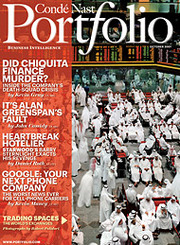Why can’t Portfolio magazine generate any buzz?
n

nn
In a recent blog entry, she compared Conde Nast’s Portfolio magazine and Time Warner’s Fortune magazine side-by-side to see where there were differences in content. While both business magazines are products of huge media conglomerates, it turns out that Fortune’s articles are more buzz-worthy. As Lois points out with a reference to a handy-dandy chart, there are three key problems with Portfolio:
nn
(1) The articles are too heavy on fear and anxiety for a business audience. “While both publications run about the same number of personal stories and glitz and glam features, Portfolio, unlike Fortune, runs many articles that raise apprehension, fear, doubt and anxieties about different businesses or business trends.” (Yo, Chiquita death squads, anyone?)
nn
(2) There’s not enough emphasis on tracking future trends. “Another difference is that Fortune features five stories on “avalanches about to roll,” those big trends about to happen, compared to just two in Portfolio.“
nn
(3) There aren’t enough how-to or aspirational stories. “Business people love how-to stories and a reason to believe in something or someone. Yet Portfolio has neither type of story.”
nn
The blog post from Lois is fascinating on another level as well. It’s an example of an author transforming a book from a “product” into a “tool”? By using her “buzz framework” for analyzing the content in Portfolio and Fortune, Lois Kelly is presenting readers with an example of how to use her thinking and insights as a tool for examining how “buzz-worthy” any trend or phenomenon might be.
nn
[image: Portfolio magazine cover]
n




